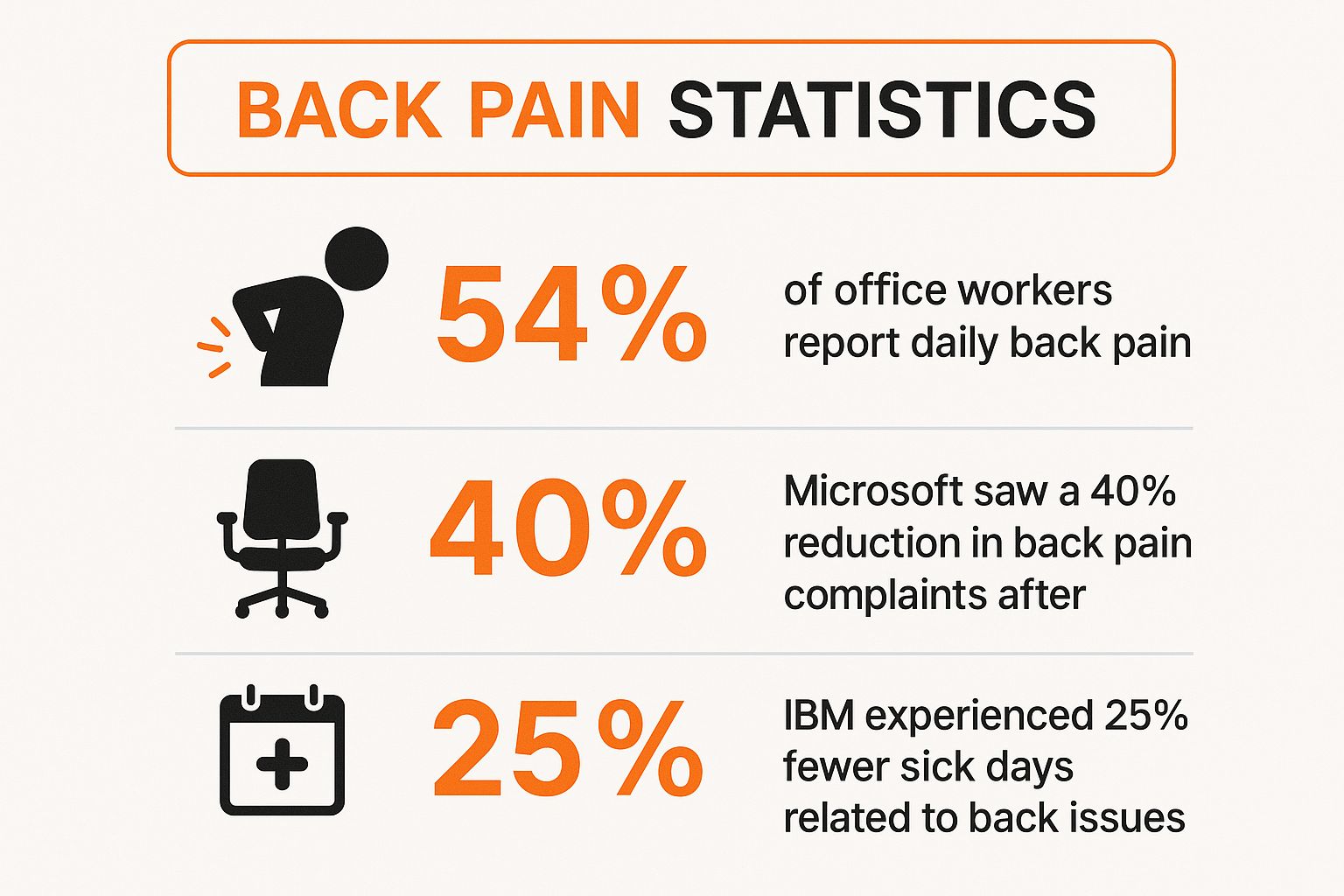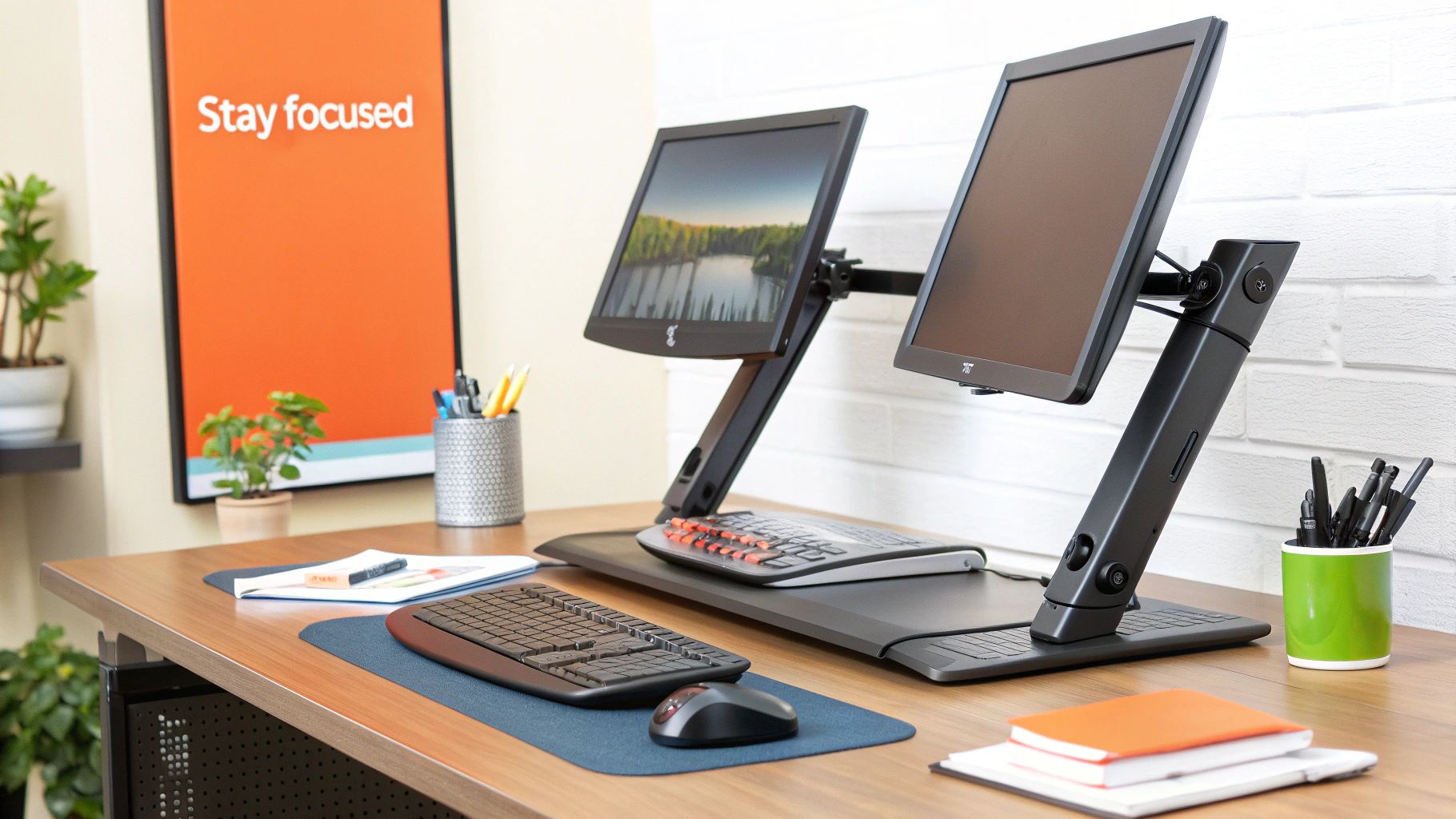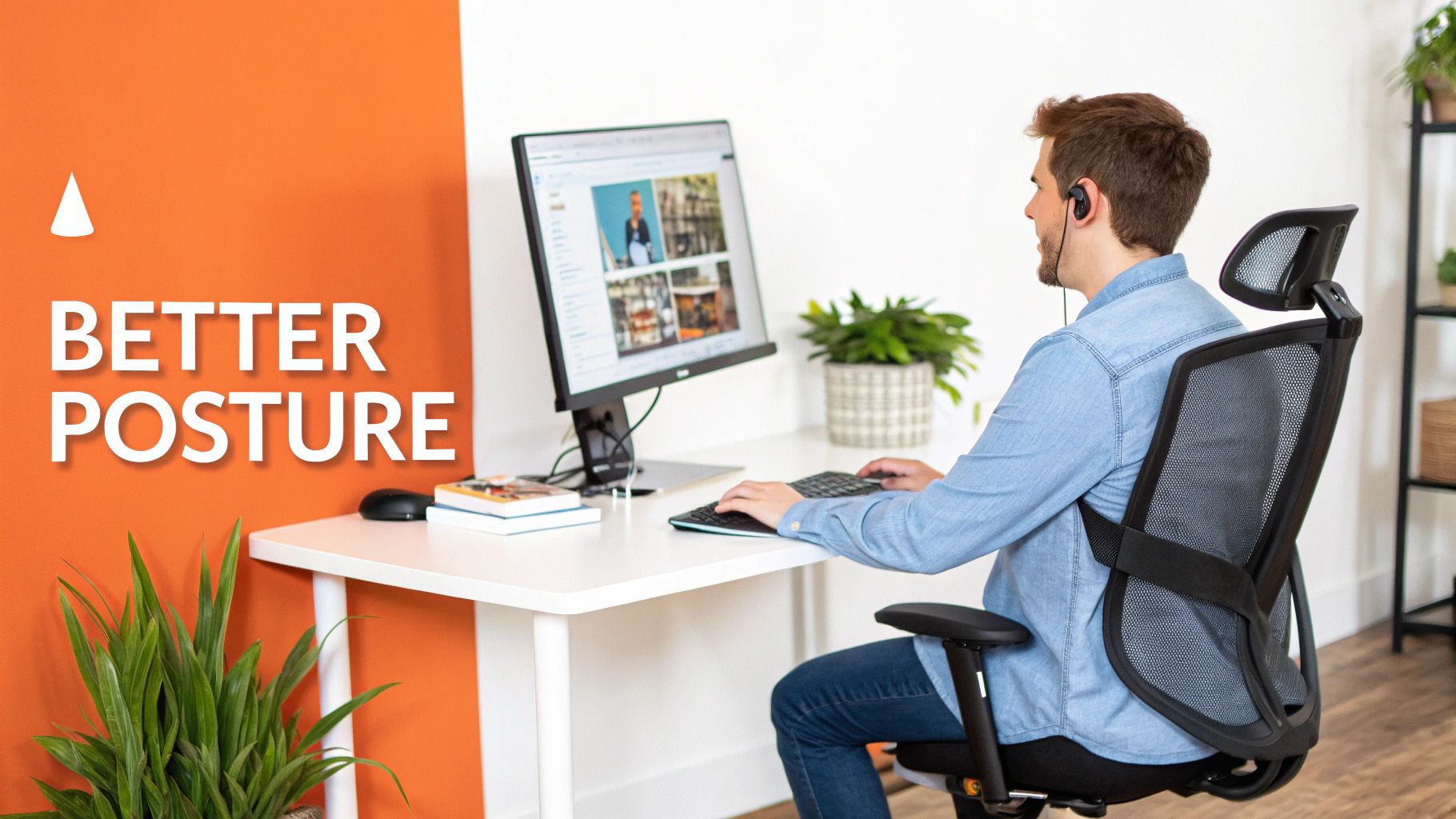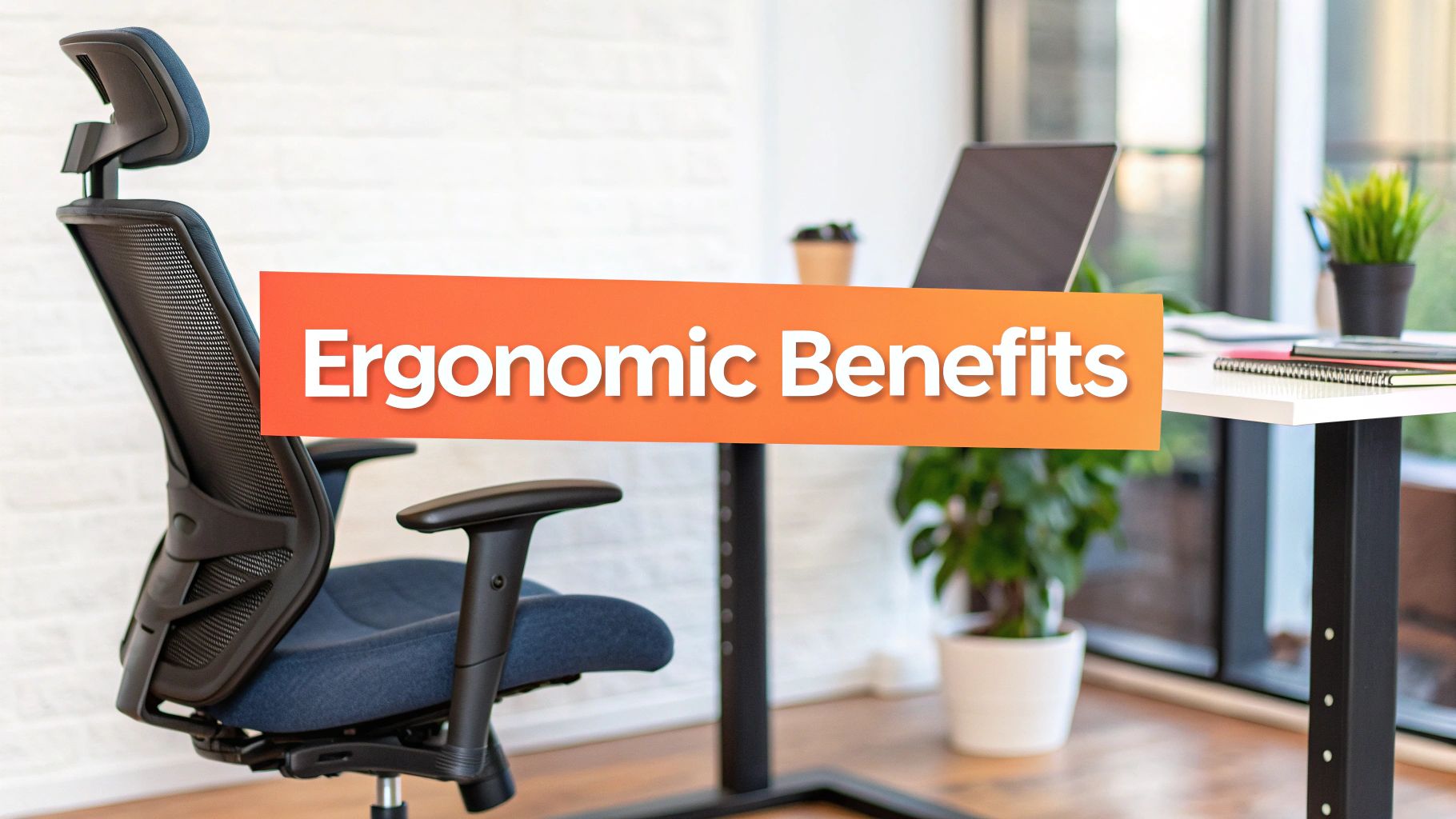In today's modern workplace, the hours spent at a desk are longer than ever. While a standard office chair seems like a simple purchase, the hidden costs of discomfort, pain, and lost productivity can be staggering. The solution isn't just about comfort; it's about investing in your health and efficiency. This guide moves beyond generic advice to explore the significant benefits of ergonomic office furniture, offering practical, science-backed insights into how a thoughtfully designed workspace can revolutionise your workday.
We'll show you exactly how the right chair supports your body and mind, helping to prevent chronic pain, improve focus, and even boost job satisfaction. From alleviating persistent backaches to enhancing your overall mental well-being, discover how expertly engineered furniture can be a true game-changer for your professional life. Let's delve into the eight transformative advantages that make ergonomic chairs a non-negotiable asset for any serious professional or home office user in Australia. This is not just about a better chair; it's about a better way to work.
1. Reduced Back Pain and Spinal Support
One of the most significant benefits of ergonomic office furniture is its ability to combat chronic back pain, a widespread issue affecting a majority of office workers. Standard office chairs often force the body into unnatural postures, leading to strain on the lower back and misalignment of the spine. Ergonomic chairs, in contrast, are engineered to support the natural ‘S’ curve of your spine, providing critical support where it’s needed most.
This targeted support helps distribute your weight evenly, reducing pressure on the spinal discs and the surrounding muscles. A chair with quality lumbar support, like the AFRDI-approved designs from Pago International, actively maintains your spinal health throughout the workday. Investing in a chair with a substantial warranty, such as Pago's 15-year guarantee, ensures this crucial support is a long-term commitment to your well-being.
Real-World Impact and Actionable Tips
The positive effects of ergonomic interventions are well-documented. For instance, major companies like Microsoft and IBM saw significant reductions in back pain complaints and related sick days after introducing ergonomic seating.
This infographic highlights just how prevalent back pain is and the powerful impact that ergonomic solutions can have.

These figures demonstrate a clear link between proper ergonomic furniture and a healthier, more present workforce. To achieve these benefits, proper setup is key:
- Positioning is everything: Adjust your chair height so your feet are flat on the floor and your knees are at a 90-degree angle.
- Customise your support: Ensure the chair’s lumbar feature fits snugly into the curve of your lower back. You can learn more about the importance of chair lumbar support on pagointernational.com.au.
- Move regularly: Stand up, stretch, and walk around for a few minutes every hour to prevent muscle stiffness.
While ergonomic chairs are a foundational element, combining them with other healthy habits creates a more holistic approach. For those seeking additional strategies, a comprehensive guide to back pain relief and prevention can offer further valuable insights for maintaining a healthy spine.
2. Enhanced Productivity and Focus
Beyond physical comfort, another of the key benefits of ergonomic office furniture is its direct impact on productivity and mental focus. When an employee is not distracted by nagging pain or constantly shifting to find a comfortable position, their cognitive resources can be fully dedicated to the task at hand. Ergonomic setups minimise physical strain, which in turn reduces mental fatigue and allows for longer periods of sustained concentration.
An uncomfortable workstation acts as a constant, low-level interruption, pulling attention away from work. By creating an environment that supports the body, ergonomic furniture helps workers enter and maintain a state of "deep work". This is where true productivity happens, and it's made possible when physical discomfort is removed from the equation. Research consistently shows that ergonomic improvements can boost individual output significantly.

Real-World Impact and Actionable Tips
The link between ergonomics and efficiency is not just theoretical; it’s a proven business strategy. For example, Dell reported an 18% productivity increase after upgrading its workstations with ergonomic principles in mind. Similarly, a redesign at Toyota's offices led to a 22% increase in project completion speed, showcasing how a comfortable environment accelerates workflow.
These successes demonstrate that investing in employee comfort is an investment in business performance. To harness these benefits, you can implement a few simple adjustments:
- Optimise your screen height: Position the top of your monitor at or just below eye level to prevent neck strain and keep your focus forward.
- Create an efficient workspace: Keep frequently used items like your phone, notepad, and water bottle within easy arm's reach to minimise unnecessary stretching and movement.
- Maintain neutral wrists: Adjust your keyboard and chair height so that your wrists remain straight and in line with your forearms as you type.
- Use a document holder: If you frequently reference papers, place them on a holder next to your monitor. This prevents you from repeatedly looking down and straining your neck.
While a well-organised desk is crucial, so is stepping away from it. Combining an ergonomic setup with regular, short breaks is a powerful formula for peak performance. You can discover more about the vital role of taking breaks at work for enhanced productivity to further boost your focus throughout the day.
3. Prevention of Repetitive Strain Injuries (RSI)
Ergonomic furniture is fundamental in the prevention of Repetitive Strain Injuries (RSI), a group of conditions affecting millions of office workers. Issues like carpal tunnel syndrome and tendonitis often arise from performing repetitive tasks, such as typing and mouse use, in awkward or unsupported positions. Ergonomic chairs and accessories are specifically designed to promote neutral joint postures, reducing the strain on your wrists, hands, and arms.
By supporting your body correctly, ergonomic solutions minimise the physical effort required for everyday office tasks. An adjustable chair allows you to align your arms parallel to your desk, keeping your wrists straight and relaxed. This careful alignment, a core principle of ergonomic design, significantly lowers the risk of developing these painful and debilitating injuries over time, contributing to long-term health and productivity.
Real-World Impact and Actionable Tips
The effectiveness of ergonomic interventions in reducing RSI is well-established. For example, aerospace giant Boeing implemented a comprehensive ergonomics program and saw a remarkable 75% reduction in RSI cases. Similarly, major newspapers have cut their rates of strain injuries by as much as 60% by introducing ergonomic keyboards and proper workstation setups.
These examples highlight a clear connection between thoughtful ergonomic design and a significant decrease in workplace injuries. To protect yourself from RSI, proper setup and daily habits are essential:
- Maintain neutral wrists: Adjust your chair and keyboard height so your wrists remain straight and in line with your forearms while typing.
- Minimise mouse use: Learn and use keyboard shortcuts for common commands to reduce repetitive clicking and wrist movements.
- Take micro-breaks: Pause every 20-30 minutes to stretch your hands, wrists, and fingers, relieving accumulated tension.
- Vary your tools: Alternate between different input devices, such as a vertical mouse or trackball, to change the muscle groups you use.
A proactive approach to ergonomics is the best defence against long-term strain. For more detailed strategies, you can learn more about workplace injury prevention on pagointernational.com.au.
4. Improved Posture and Reduced Neck Strain
Beyond just supporting the lower back, one of the core benefits of ergonomic office furniture is its ability to promote proper full-body posture. This directly combats the widespread issue of 'tech neck' and forward head posture, which develops from hunching over screens. Standard furniture often exacerbates this, but ergonomic chairs and adjustable desks guide your body into correct alignment, significantly reducing strain on your cervical spine, shoulders, and the supporting muscles.

This alignment is crucial for long-term health. A correctly adjusted setup, featuring a chair with an adjustable headrest and a monitor at the right height, can prevent the chronic pain and headaches associated with poor posture. By encouraging you to sit upright with your head balanced over your shoulders, ergonomic equipment helps restore the natural curve of your neck, which can even improve breathing and focus.
Real-World Impact and Actionable Tips
The positive effects of posture-correcting furniture are clear. For example, law firms that have adopted ergonomic setups have reported up to 40% fewer headache-related sick days among their staff. Similarly, Apple's investment in adjustable monitor arms for its open-plan offices led to a reported 55% reduction in employee complaints about neck strain, showcasing the direct link between proper equipment and physical well-being.
These figures highlight how a proactive approach to posture can create a more comfortable and productive work environment. To achieve these benefits, precise adjustments are essential:
- Monitor positioning is key: Adjust your monitor so the top of the screen is at or slightly below your eye level to prevent neck tilting.
- Relax your shoulders: Keep your shoulders relaxed and down, with your arms resting comfortably at your sides.
- Maintain a solid base: Your feet should be flat on the floor or supported by a footrest, with your knees at a 90-degree angle.
- Check in with yourself: Set hourly reminders to do a quick posture check, ensuring you haven't slipped back into old habits. You can learn how to improve posture with our detailed guide.
5. Reduced Employee Absenteeism and Healthcare Costs
Beyond individual comfort, one of the most compelling business-focused benefits of ergonomic office furniture is its direct impact on the bottom line through reduced absenteeism and lower healthcare costs. When employees suffer from musculoskeletal issues caused by poor workstation setups, it leads to more sick days, increased workers' compensation claims, and higher medical expenses for the company. Ergonomic furniture directly counters these issues by promoting healthier postures and reducing physical strain.
Investing in quality ergonomic chairs, like the durable, AFRDI-certified options from Pago International, is an investment in your workforce's health. This proactive approach minimises the risk of work-related injuries, creating a more resilient and present team. The financial return is often significant, as a healthier workforce is a more productive and reliable one, translating into substantial long-term savings for the organisation.
Real-World Impact and Actionable Tips
The financial and operational benefits are not just theoretical; they are proven. For instance, companies like Navistar have seen their workers' compensation costs drop by 58% after putting a comprehensive ergonomics program in place. Similarly, Perdue Farms reported a 44% decrease in absenteeism following an ergonomic redesign of their workplace. These examples highlight a clear return on investment.
Beyond just physical comfort, ergonomic furniture contributes to a healthier workforce, leading to fewer sick days and lower healthcare expenditures. For a comprehensive look at how to tackle employee absences, consider implementing effective absence management strategies. To see these benefits in your own organisation, a structured approach is essential:
- Track baseline metrics: Before you make changes, record current absenteeism rates, workers' compensation claims, and related healthcare costs to measure your success.
- Provide employee training: Ensure every team member knows how to properly adjust and use their new ergonomic equipment to maximise its benefits.
- Establish regular assessments: Periodically review workstations and encourage employees to report any discomfort early, allowing for swift adjustments before problems escalate.
- Create reporting systems: Implement a simple, confidential system for employees to flag discomfort, fostering a culture of proactive wellness. This can also inform future furniture choices and improve employee retention strategies.
6. Better Blood Circulation and Reduced Fatigue
A key benefit of ergonomic office furniture is its ability to improve blood circulation and combat workplace fatigue. Standard chairs often create pressure points, particularly behind the knees and on the thighs, which can restrict blood flow. This poor circulation is a direct contributor to feelings of lethargy, leg swelling, and even reduced mental sharpness as the day progresses.
Ergonomic chairs are designed to prevent this by promoting healthier postures and reducing pressure. Features like an adjustable seat depth and a "waterfall" front edge ensure that your weight is distributed correctly without cutting off circulation to your lower limbs. By allowing for natural movement and proper positioning, these chairs help maintain healthy blood flow, leading to higher energy levels and a noticeable reduction in that all-too-common afternoon slump.
Real-World Impact and Actionable Tips
The link between ergonomic design and energy levels is backed by significant workplace improvements. For example, call centres that implemented proper ergonomic seating saw a 25% improvement in employee alertness scores, while financial firms using sit-stand desks reported a 20% increase in sustained energy throughout the day. These outcomes highlight how furniture choices directly impact an individual's vitality and stamina.
The research pioneered by institutions like the Mayo Clinic on workplace health has consistently shown that reducing sedentary pressure is vital for circulation. To harness these benefits and keep your energy high, proper setup is crucial:
- Align your thighs: Adjust your chair height so your thighs are roughly parallel to the floor, allowing blood to flow freely.
- Mind the gap: Ensure there is a small gap of about two to four inches between the front edge of the seat and the back of your knees to avoid pressure on nerves and blood vessels.
- Use a footrest: If your feet don't rest comfortably flat on the floor after adjusting your chair, a footrest can provide the necessary support to maintain correct posture and circulation.
- Incorporate movement: Take short walking breaks every hour to stimulate blood flow and prevent the negative effects of prolonged sitting.
7. Enhanced Mental Well-being and Job Satisfaction
The benefits of ergonomic office furniture extend beyond physical health, significantly influencing mental well-being and overall job satisfaction. Continuous physical discomfort, even if minor, can act as a persistent stressor, leading to irritability, reduced focus, and a general decline in mood. When employees feel physically supported and comfortable, this distraction is removed, allowing for greater mental clarity and reduced stress levels.
An ergonomic workspace signals that an employer values the well-being of their team, which directly boosts morale and a sense of appreciation. This investment in employee comfort, such as providing high-quality, adjustable chairs, cultivates a positive work environment where people feel cared for. This supportive atmosphere is a key driver of higher job satisfaction and long-term loyalty.
Real-World Impact and Actionable Tips
The link between a comfortable physical environment and a positive mental state is well-established by workplace psychology researchers. For example, major tech companies like Salesforce have reported employees having 35% higher job satisfaction after ergonomic office redesigns. Similarly, healthcare organisations that implemented ergonomic workstations saw a 42% reduction in stress-related complaints from staff.
Beyond the direct physical benefits, ergonomic furniture also contributes to a positive work environment, fostering enhanced mental well-being and job satisfaction. Similarly, incorporating effective employee engagement activities can further boost morale and connection within a team. This proves that a thoughtful approach to the work environment yields powerful results.
To harness these psychological benefits, consider these actionable steps:
- Involve employees in selection: Allow team members to have a say in their furniture choices, as this empowers them and ensures a better fit for their individual needs.
- Provide training: Educate staff on the mental health benefits of ergonomics and show them how to properly adjust their equipment to maximise comfort.
- Encourage personalisation: Let employees personalise their workstations. A space that feels their own contributes to a sense of belonging and comfort.
- Conduct regular check-ins: Ask employees about their comfort and satisfaction with their setup, making adjustments as needed to show ongoing support.
8. Long-term Cost Savings and ROI
While ergonomic furniture may have a higher initial purchase price, one of its most compelling benefits is the substantial long-term financial return it delivers. Viewing this purchase as an investment rather than an expense is key, as it generates savings through reduced healthcare costs, decreased absenteeism from work-related injuries, and lower staff turnover. A healthier, more comfortable workforce is also a more productive one, directly contributing to a stronger bottom line.
The return on investment (ROI) for ergonomic programs is well-documented, with studies often showing returns from 3:1 to as high as 17:1 within the first year. Furthermore, high-quality ergonomic furniture is built to last. Designs from Pago International, for instance, come with an extensive 15-year warranty, meaning you avoid the recurring expense of replacing cheaper, less durable chairs every few years. This durability dramatically lowers the total cost of ownership over the lifespan of the furniture.
Real-World Impact and Actionable Tips
The financial benefits are not just theoretical; major corporations have seen significant savings. For example, IBM's ergonomics program generated $1.8 million in its first year, while retail giant Walmart saved an estimated $3.5 million annually through similar interventions. Even small businesses typically realise a 300-500% ROI on their ergonomic investments, making it a sound financial decision for companies of any size.
These figures illustrate that investing in your team's physical well-being is one of the shrewdest financial moves a business can make. To maximise your return, consider these tips:
- Calculate total cost of ownership: Look beyond the initial price tag. Factor in the lifespan, warranty, and potential savings from reduced sick days when comparing options.
- Track key metrics: Before and after implementation, monitor metrics like absenteeism, reported discomfort, and productivity to quantify the impact of your investment.
- Phase your implementation: If a full-scale rollout is not financially viable, start with a single department or a group of employees with the most critical needs to spread the cost over time.
- Prioritise quality and longevity: Investing in a chair with a long warranty, like those from Pago, ensures you are making a purchase that will serve your business for over a decade, preventing future replacement costs.
Benefits Comparison of 8 Key Ergonomic Furniture Features
The Smart Choice for Your Health and Your Bottom Line
Transitioning from a standard office chair to a properly designed ergonomic one isn't just a minor upgrade; it's a fundamental shift in how you approach your workday and your long-term health. The evidence we've explored is overwhelming. The numerous benefits of ergonomic office furniture create a powerful ripple effect, touching everything from your physical comfort to your professional output and even your organisation's financial health.
We’ve seen how targeted support, like the adjustable lumbar systems found in Pago chairs, directly combats the pervasive issue of back pain, safeguarding your spine for years to come. By promoting correct posture, these chairs alleviate the neck and shoulder strain that so often leads to chronic headaches and discomfort. This physical foundation is crucial, as it allows for enhanced focus and sustained productivity throughout the day. When you're not constantly shifting to find a comfortable position, your mental energy can be channelled directly into your most important tasks.
Beyond Comfort: A Strategic Investment
Thinking bigger, the impact on business operations becomes crystal clear. An investment in ergonomics is a proactive strategy to prevent debilitating conditions like Repetitive Strain Injuries (RSI) and to improve blood circulation, which fights off afternoon fatigue. For businesses, this translates directly into tangible results: reduced employee absenteeism, lower healthcare-related costs, and a significant boost in overall morale and job satisfaction.
Ultimately, choosing ergonomic furniture is one of the smartest investments you can make. It delivers immediate returns in comfort and focus, while also providing substantial long-term value by preventing future health issues and maximising productivity. It's a clear win for individual employees and a strategic advantage for any forward-thinking organisation.
Key Takeaway: The decision to invest in ergonomic furniture is a proactive step towards a healthier, more productive, and more satisfying work life. It's not a cost; it's an investment in the most valuable asset of any company: its people.
Your next step is to move from understanding these benefits to experiencing them firsthand. Assess your current workspace. Are you experiencing any of the common pain points we discussed, such as back strain, neck stiffness, or afternoon slumps? Don't wait for these minor annoyances to become chronic problems. Take action by exploring chairs that offer the specific adjustments and AFRDI-certified quality needed to create a truly supportive environment. This is your opportunity to build a workspace that works for you, not against you.
Ready to experience the transformative benefits of ergonomic design for yourself? Explore the full range of customisable, AFRDI-approved office chairs from Pago International. With industry-leading warranties and a design philosophy centred on your health and productivity, we have the perfect seating solution for your home or office.


